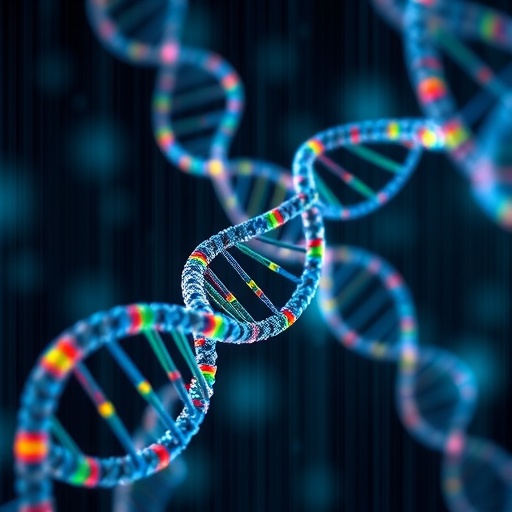In a breakthrough that promises to significantly advance the field of cancer diagnostics, researchers from The University of Chicago have unveiled a revolutionary approach to DNA methylation analysis, called Ultra-Mild Bisulfite Sequencing or UMBS-seq. This novel method overcomes the critical limitations of existing technologies, offering a combination of accuracy, gentleness, and efficiency that could redefine how scientists and clinicians detect and monitor cancer through epigenetic markers.
DNA methylation, the attachment of methyl groups to the DNA molecule, plays an essential role in regulating gene expression. This biochemical modification influences cellular function, turning genes on and off without altering the underlying DNA sequence. Aberrant methylation patterns are intimately linked to cancer development, often silencing tumor suppressor genes or activating oncogenes. Accurate profiling of these methylation marks is therefore vital for early cancer detection, therapy selection, and monitoring treatment response, especially using minimally invasive liquid biopsies.
Historically, bisulfite sequencing has served as the gold standard for methylation detection. This technique converts unmethylated cytosines into uracils, which are read differently during sequencing, while leaving methylated cytosines unaltered. However, traditional bisulfite treatment is harsh; the chemical reactions involved severely fragment DNA, particularly problematic when working with the extremely limited and fragile DNA present in blood samples or formalin-fixed tissues. This damage results in biased, incomplete data and compromised reproducibility.
To mitigate this, enzyme-based alternatives like enzymatic methyl-seq (EM-seq) have emerged. These methods utilize enzymes to detect methylation marks under milder conditions, thereby preserving DNA integrity. Nonetheless, these enzyme-based protocols remain complex, often require labor-intensive workflows, and suffer from pronounced false positive rates, especially when sample DNA input is low—common in clinical liquid biopsy settings. This inconsistency undermines their reliability for clinical applications.
UMBS-seq breaks this stalemate by fundamentally reengineering the bisulfite chemistry itself instead of abandoning it. Led by Professor Chuan He, the research team refined the chemical formulation and meticulously optimized reaction parameters to achieve near-complete cytosine conversion while maintaining ultra-mild reaction conditions. This approach retains the high confidence of bisulfite sequencing but minimizes DNA degradation dramatically.
Extensive head-to-head comparisons demonstrated that UMBS-seq surpasses both conventional bisulfite and enzymatic sequencing technologies across multiple critical metrics. The method yields higher library complexity and integrity, ensuring more uniform genomic coverage. Importantly, it provides exceptional conversion efficiency, translating into highly accurate methylation calls that are crucial for detecting subtle epigenetic changes linked to early cancer states.
One of UMBS-seq’s standout advantages is its streamlined protocol. Unlike enzymatic methods, which are time-consuming and technically demanding, the UMBS-seq workflow simplifies experimental procedures, reducing turnaround times without sacrificing data quality. This makes it attractive not just for research laboratories but also for clinical testing environments where speed and reliability are paramount.
Applying UMBS-seq to human cell-free DNA—fragments circulating in blood—revealed its superior capacity to preserve DNA integrity and generate comprehensive coverage of cancer-associated methylation sites. This capability is transformative for liquid biopsy approaches aiming at non-invasive cancer diagnostics, where the amount of available DNA is minuscule and extremely susceptible to damage.
The researchers envision that UMBS-seq will soon become the new benchmark for DNA methylation analysis, broadly adopted in both investigative and diagnostic domains. By enabling more sensitive, reproducible, and cost-effective epigenetic profiling, this technique could accelerate the deployment of methylation biomarkers in clinical oncology, paving the way for earlier detection and more personalized treatment regimens.
Capitalizing on this innovative science, Ellis Bio Inc., a biotechnology company spun out from The University of Chicago, has secured exclusive licensing rights to UMBS-seq. The company is developing the SuperMethyl™ Max kit, built on this technology, to deliver ready-to-use tools tailored for cancer diagnostic test developers. An early-access program for the SuperMethyl Max kit is currently available, promising to bring this cutting-edge solution into the hands of researchers and clinicians globally.
Ruitu Lyu, the incoming Chief Technology Officer at Ellis Bio and co-author of the UMBS-seq study, emphasized the significance of this advance. “With UMBS-seq and the SuperMethyl Max kit, we can now read cancer’s epigenetic code without destroying the very few and precious molecules we need to study. It’s a practical, scalable solution that could accelerate the clinical use of methylation biomarkers for early detection and personalized therapy,” he stated.
As the landscape of cancer diagnostics shifts increasingly towards non-invasive tests based on liquid biopsies, technologies like UMBS-seq that preserve DNA integrity and improve analytical precision will be essential. This breakthrough method not only addresses long-standing technical challenges but also opens new avenues for understanding the epigenome’s role in cancer and other complex diseases.
The implications of UMBS-seq reach beyond oncology. Because methylation patterns also impact numerous biological processes and diseases, this technology could broaden epigenetic research horizons in neuroscience, immunology, aging, and more. With the promise of detailed, accurate methylation mapping from minimal DNA input, researchers will be empowered to dissect epigenetic regulation with unprecedented clarity.
In sum, UMBS-seq represents a significant scientific and technological leap that elegantly balances the biochemical rigor of traditional bisulfite sequencing with gentle reaction conditions to protect DNA. This advancement underscores the power of innovative chemistry combined with thoughtful experimental design to solve critical biomedical problems, setting a new standard for epigenetic analysis and clinical diagnostics in the 21st century.
Subject of Research: Human tissue samples
Article Title: Ultra-mild bisulfite outperforms existing methods for 5-methylcytosine detection with low input DNA
News Publication Date: 13-Nov-2025
Web References: 10.1038/s41467-025-66033-y
References: Nature Communications article authored by Professor Chuan He et al.
Image Credits: Not specified
Keywords
UMBS-seq, DNA methylation, bisulfite sequencing, epigenetics, cancer biomarkers, liquid biopsy, enzyme-based sequencing, DNA integrity, epigenome, cancer diagnostics, 5-methylcytosine, SuperMethyl Max kit




